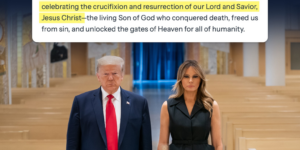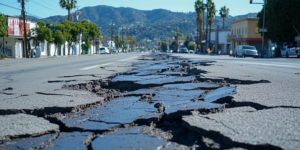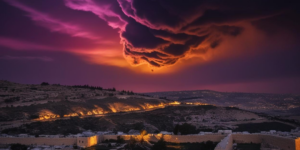Memories of the Pentecostal Outpouring Bring Goosebumps
Note: This article was originally published in the April 1996 issue of Charisma magazine.
When 88-year-old Elsie Mason was born, Teddy Roosevelt was president of the United States and the American West was still being tamed. Arizona and New Mexico weren’t even states yet. The automobile assembly line had just been invented, but paved roads were still uncommon. Women wore floor-length skirts and couldn’t vote. Only rich people had telephones.
The term “Pentecostal” was rarely used to describe any group of Christians. Although Holiness churches taught that believers should seek a spiritual experience they called “sanctification,” it was a revival in Topeka, Kansas, in 1901, and the subsequent and more far-reaching Azusa Street Revival of 1906, that popularized the belief in the baptism of the Holy Spirit. Azusa triggered a Pentecostal movement that today represents some 430 million people worldwide.
Mason, the widow of Charles H. Mason—founder of the Church of God in Christ—is one of several older Pentecostals who remember the early days of camp meetings, tent revivals and backwoods persecution. By talking with her, and with nine other elderly saints, Charisma has collected a treasure chest of oral history…
Pauline Parham, 86, grew up hearing about the Pentecostal outpouring that occurred in 1901. Her father-in-law, Charles Parham, led that revival, which proved to be a forerunner of the Azusa movement. She remembers that Parham rented a beautiful building in Topeka for $40 a month to house his Bible school:
… Forty students lived there. They planned an all-night prayer meeting for New Year’s Eve, and a woman named Agnes Ozman asked Dad Parham to lay hands on her and pray for her to receive the baptism in the Holy Spirit.
He said he couldn’t pray for her since he hadn’t received it yet, but she said just do it anyway in the name of the Lord. She was actually the first one to receive the gift of tongues.
The meeting went for three days—day and night—and she could hardly speak English because the Lord gave her another language. The fame of this meeting went throughout the community, and many newspaper reporters came. When they interviewed Agnes Ozman, she responded in the Chinese tongue she had received. For three days she could only speak in Chinese.
Fred Griesinger, 95, was 5 years old when the Azusa revival erupted. He remembers the crude benches inside the barnlike Azusa Street building, and a horse-drawn ice cream wagon that was sometimes parked in front:
… I don’t believe there was a membership there. The people came from every direction and were hardly identified with each other. When the service would start, it wouldn’t take long before the Holy Spirit would come down
People didn’t even have lunch. They would go on through the noon hour and on into the afternoon. There was very little preaching. There was a lot of good singing and worship, and it was repetitious. They would sing, “The Comforter has come; the Comforter has come.”
Stanley Horton, 80, was born 10 years after the Azusa revival. But both his parents attended the meetings at Azusa. His father, Harry Samuel Horton, told him much about the early days:
… When my father was 21, he and another young man decided to work their way across Canada and then down to California. He was actually running from God. Everywhere he went, revivals were going on, and his friend would want to go to them, but he refused.
The day before the 1906 San Francisco earthquake, he was walking in Golden Gate Park when an inner voice spoke to him saying, “Get out of this city!” It grew stronger and stronger. Finally he got his friend and took the ferry across the bay to Oakland.
The earthquake demolished the place where they had been staying. Undoubtedly they would have been killed if they had stayed there.
Shortly after that my father was walking by a Nazarene church in Oakland on a Wednesday night. He felt impelled to go in.
He kept crying out, “God, forgive me, a sinner,” but he felt no response from the Lord until the pastor quoted the verse, “Him that cometh to me I will in no wise cast out.” Then the burden rolled off, and my father walked out feeling as if he were walking on air.
A few days later he passed a street meeting in Oakland where they were telling how the Holy Spirit had been poured out according to Acts 2:4 at the Azusa Street Mission in Los Angeles.
At age 12, Fred Griesinger was baptized in the Holy Spirit at a camp meeting in Los Angeles in 1913. His seven brothers and sisters lived in tents and dug their own well at the camp:
… One evening they had a young people’s tent meeting. I wandered into the meeting by myself. They were singing and praising the Lord and testifying. So I didn’t see any reason why I shouldn’t testify.
So I thanked the Lord that I was saved and said that I wanted to be filled with the Holy Spirit. At that moment I was taken out of this world—completely unconscious. I didn’t know whether I was sitting down or standing or what. And when I came to I was speaking in tongues and my hands were up, and no one was paying attention to me.
No one ever laid hands on me. Nobody preached to me. I couldn’t talk in English for hours.
Sarah Harrell, 93, was present at a meeting in Hot Springs, Arkansas, in 1914 when the Assemblies of God was formed. She remembers the camp meeting days:
… I was a very small girl when Pentecost came to our town in Arkansas. The preachers—Brother and Sister Shelton—came and rented a little storefront.
They lived in a houseboat on the Mississippi River. At that meeting, my grandmother was saved, my mother and stepfather were saved, and my aunt.
Two years later my mother and stepfather went into the ministry. We held lots of meetings in little towns. A lot of people were saved in the camp meetings. They had a tent for the meeting, a tent for the dining room, and they slept in tents.
They didn’t have cots. Farmers would bring in straw, and they’d put it on the ground, and we’d spread our quilts on that.
It was rough. We didn’t have cars in those days; everybody rode the train.
As a child, Rolf McPherson, now 83, traveled with his famous evangelist mother, Aimee Semple McPherson. She led crusades on the East Coast during the early years of this century before moving to California, where she founded the Foursquare denomination:
… There were very few cars in those days. If you traveled in one you had to be careful that you didn’t get stranded in the wilderness. So you often traveled in caravans. The roads were very difficult. I remember when we came to California we had to cross over the Rockies, and the roads were very narrow.
You could look right down the side for several thousand feet down. My grandmother was nervous, holding her breath the whole time and wondering if we’d make it. Sometimes you’d meet a car, and you had to back up to let the car go by.
Elsie Mason, 88, was married to Bishop C.H. Mason, founder of the Church of God in Christ. She remembers the particular struggles of black Pentecostals:
… Negroes weren’t allowed in the hotels in those days—only as employees. During our Holy Convocation in Memphis they would sleep in the different homes. Many would sleep all night in the church on benches.
All of the South was quite prejudiced, and there was always separate seating, even in churches. Negroes weren’t to sit with the whites or the whites with the Negroes. Once, Bishop Mason had an incident when a white man embraced him in one of his meetings in Nashville, Tennessee, and it caused quite a stir among the white people.
But the Lord always took care of Bishop Mason. He didn’t shy away from other races. He always said, “All souls are God’s.”
Rolf McPherson remembers that his mother preached in black churches at a time when interracial ministry was not accepted:
… There were only a few thousand blacks in Los Angeles in the 1920s. But all of a sudden—about the time of the Depression—they began to come to Los Angeles and they had a tough time.
They came out here and tried to develop work and factories, but it was very difficult. They established communities where they had their churches.
Mother would often preach for them, or they would come to our church, Angelus Temple. It was always wide open, and many of them were our best friends.
When she was preaching in the South, she’d often preach to the white community, and then she would go across the tracks and set up the tent for the black people.
They were welcome in any of the meetings, but they couldn’t always come across to the other community, so she would go and hold an extra week for them. She loved the black people. She would bring barrels of clothes and supplies for them.
Lelia Mason Byas, 77, daughter of Bishop C.H. Mason, talked often with her father about the early days of the Church of God in Christ, when it was extremely difficult for black ministers to travel:
… I often wondered why Bishop Mason was not mobbed or lynched during the days of strict segregation. I asked how he got his early ministry started, and he told me that when the Lord led him to go to a place, he would walk.
He didn’t own a mule or a buggy or a horse or a wagon. He was a very poor man, so how he survived I just don’t know.
Cities were far apart in those days, so I asked him how he found his way through the woods. He said he would follow the railroad track.
The track would always lead to a train station, and at the station there would always be a cotton gin and a grain mill. That’s where he would meet black folks.
I asked him how he would find housing. He said he would go out and pray and minister to the people, and there would always be somebody kind enough to ask him to go home with them.
Rolf McPherson recalls the excitement of an Aimee Semple McPherson crusade in the 1920s
… Mother would preach continually, probably three times a day. That would go on for a month, and then we’d move to the next town.
All of Mother’s meetings were full of enthusiastic people. They packed the place.
You didn’t have public address systems in those days, so Mother had to be able to speak to several thousand people in a tent—which absorbs all of the sound. But somehow she managed to do it. Her throat was probably twice as large as the average person’s.
They used to bring ambulances and stretchers, and they left empty. Often Mother would—right in the middle of her message—go down and pray for somebody on a stretcher. They would get up off the stretcher, and the stretcher would be carried off empty.
Carl O’Guin, 100, got involved in the Assemblies of God when it was formed in 1914. He remembers how mainline Protestant ministers were swept into the Pentecostal movement after attending Aimee Semple McPherson’s meetings:
… I came to pastor in Granite City, Illinois, in 1919. In 1921 we got Aimee Semple McPherson over in St. Louis at a big Masonic Temple. There was a Methodist pastor over there named Markley. He liked the meeting, and he was an emotional, shouting Methodist type.
Sister McPherson told him: “I just held a meeting in Washington, D.C., and there was a Methodist pastor named Charles Shreve who got the baptism in the Spirit. I would like you to get Dr. Shreve to come to your church and hold a revival.”
Markley took her up on it. This Dr. Shreve was as bold as the dickens. He came right out there in that Methodist church, and he began to preach, “The glory, and the fire, and the power of the Holy Ghost is coming on the world,” and people began to receive the Holy Ghost.
About 60 of them got the baptism before the bishop came and put them all out.
Rolf McPherson recalls how Aimee Semple McPherson’s ministry helped thousands of people during the Great Depression of the 1930s:
… People were coming to California in great numbers and arriving here with absolutely nothing. Mother would see that they had all the help she could get.
The fire department and the police department brought people to the church’s commissary. We had a group called The City Sisters who filled baskets all day for poor people. People stood in long lines to receive.
It was a difficult job to feed all the people that needed help. The children didn’t have lunches to go to school with, and the people at Angelus Temple would prepare the lunches and get milk for them so the children wouldn’t go hungry. It was probably the only meal they had.
Daphne Brann, 105, got ministerial credentials with the Assemblies of God in 1917. She remembers how the Great Depression affected her church:
… When the Depression hit, we were in Mansfield, Ohio. We had a lot of farmers in our church, and they were always bringing us food. So we didn’t feel the Depression like others did. Although I remember one week, after all the bills were paid, all we had to live on was the $6 our son made selling papers in front of the bank on Main Street.
We would go out on a Saturday, and when we came home the big, round kitchen table would be loaded with food. Some of the farmers had cows, so they would bring milk, butter—everything.
On a Saturday night my husband used to have street meetings in the square in Mansfield before the service. People would go out and buy groceries and put them on the entranceway of the church for us. I loved the tomatoes and the corn.
Arthur Burt, 84, a British evangelist, met evangelist Smith Wigglesworth on several occasions. He remembers how the Pentecostal movement impacted England in the 19305, confirming that “holy laughter” is nothing new:
… I had been expelled from the Protestant Truth Society because I had embraced the Pentecostal message and because I had spoken in tongues. In 1934 I landed at a convention in the Midlands.
I went into that meeting a puffed-up, arrogant young man. At that time, no meeting was a good meeting unless I was speaking in it. I came into the meeting, and a brother stood up and declared, “Quench not the Spirit.”
Down came the Holy Ghost in waves and waves. Everything happened at once.
Some people were on the floor. Some had their hands up. Some were weeping. Some were shouting. Some were speaking in tongues. Some were laughing. Some were pushing handkerchiefs in their mouths to stop the noises they were making.
I stood up to minister, but God didn’t seem to take any notice of me. I lifted my voice, but God lifted the crescendo in the meeting.
I lifted my voice higher, expecting all the noise to subside. But it didn’t.
So here I was, a little peacock trying to compete with the mighty Spirit of God. A brother behind me pulled my jacket coattails, and he said: “Sit down. Don’t you know the touch of the Spirit of God in a meeting?”
I was silenced as the people laughed in the Spirit while others wept. All kinds of emotions were rolling through like an incoming tide.
In many of those meetings people would laugh and laugh. Some people rolled off their seats and fell on the floor.
Black communities in the United States were greatly impacted by Bishop C.H. Mason’s Pentecostal crusades in the 1930s and 1940s, according to Elsie Mason:
… In Texas there were great crowds. He would leave the tent and go out in the open. Wherever he saw the crowds of people, he would go. There was hardly a village in Texas that hadn’t heard of the Church of God in Christ.
Crutches were lined up against the walls because the people didn’t need them any more. And people were raised from the dead.
In Memphis, a lady took sick during our convocation, and at that time doctors weren’t as prevalent as they are today, and there were hardly any hospitals for Negroes. So they sent for Bishop Mason, and he prayed until the Lord raised her.
Nora Bryant Jones, 99, lived in the backwoods of eastern Tennessee when the Azusa revival began. Her father, W.F. Bryant, founded the Church of God in Cleveland, Tennessee. She remembers how Pentecostals were persecuted in the early days:
… Some people used to pollute our springs with kerosene so we couldn’t drink the water. One of my early jobs was to get water for the home, so I remember that very dearly.
Our house was shot at and pelted with rocks lots of times so that the windows were broken out. We children were not hurt by anybody, but my daddy was. I remember how the bad men tried to kill him many times.
One time he was shot with a shotgun. Sometimes Mom had to hide my daddy, and we children had to help. We hid him under quilts and sat on them so the men with guns couldn’t find him.
Sometimes he would have to hide out in the barns or woods to keep from being killed. One time my mother was taking us children to a prayer meeting when a man with a gun stood in the creek we had to cross and he screamed at us to go back.
Sarah Harrell also remembers being frightened as a child because of persecution:
… People thought we were strange. They threw rocks at the preachers. One time a crowd of people threw eggs on our church. I was scared to death. I hung onto my mother. But I don’t remember anybody throwing anything back.
Once, someone tried to burn Arthur Burt’s church in Great Britain:
… We were called “the tongues people.” Critics said of us: “They roll on the floor, they climb the walls, they’re devil-possessed.” So, basically, to be identified with Pentecostals meant you were a leper.
During the visitation in the 1930s, our meetings would go on until 1 or 2 o’clock in the morning. This was every night. We met regardless of land mines and German bombers.
There was a woman who was married to an unsaved man. She went to the meetings and unwisely went home at about 2 o’clock in the morning.
That provoked her husband to anger. He couldn’t believe that religious meetings would go on that late, so he accused her of carrying on a secret affair and locked her out of the house.
My wife and I offered her a room. From that time he spread the news that I had stolen his wife. Whenever I went out to the shops or in the village, people looked at me critically. It was just the price that you paid.
Then one night the door of the hall opened, and in he came, half drunk. He staggered down the aisle, and he cursed me.
He swore at me and pulled out a gun, and I just waited to be shot. He didn’t shoot, but he went in the back of the room and set the place on fire.
Radio was a major means of outreach for Aimee Semple McPherson, who was the first woman in the United States to obtain an FCC license to operate a station. Rolf McPherson recalls a remarkable conversion that occurred in the 1930s as a result of radio:
… A woman named Mary Elizabeth ran a house of prostitution here in Los Angeles. She was into drugs, and they had put her in jail and said, “You might as well throw the key away; she’ll never get out.”
But she heard a radio broadcast in that jail, a sermon that Mother was preaching, and she begged those people: “Please take me there. I know if I can get there, God will heal me.”
So they did. They put her in the police car, handcuffed, and at the front door they took the handcuffs off and let her run down the aisle. She knelt at Mother’s feet, and Mother prayed for her.
She was totally healed from the drugs. Her life was changed. She went back and closed the house of prostitution and made it a house for wayward girls and helped rescue them. It was a miracle.





































